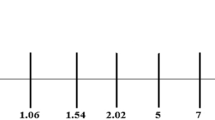Abstract
A numerical investigation on the effects of small tripping rods on the fluid force reduction on a big structure has been carried out using finite volume method where a configuration of a circular cylinder with two small tripping rods symmetrically placed very near to its front surface is studied. The diameter ratio of the rods and the cylinder is set at 0.08, 0.10 and 0.12, and the gap between the rods and the cylinder is fixed at 0.08 of the cylinder diameter. The angular position of the rods varies from 20° to 60°. The effects of the tripping rods on force reduction, vortex shedding frequency and flow separation have been examined for various arrangements of the rods with Reynolds number focused on 200 for laminar flow and 5.5×104 for a turbulent flow. The results reveal that there exits an optimum position where the time averaged force coefficients acting on the cylinder all reach their minimum values and at the same time Strouhal number meets its maximum. At the optimum position the drag coefficient is reduced by 18% for Re=200 and 59% for Re=5.5×104. Further investigation with tripping rods placed near the separation points is also carried out for Re=5.5×104 and a considerable drag reduction is found.
Similar content being viewed by others
References
A lam, M. M., Sakamoto, H. and Moriya, M., 2003, “Reduction of Fluid Forces Acting on a Single Circular Cylinder and two Circular Cylinders by using Tripping rods,”Journal of Fluids and Structures, Vol. 18, pp. 347–366.
Bearman, P. W., 1965. “Investigation of flow Behind a Two-Dimensional Model with Blunt Trailing Edge and Fitted with Splitter Plates,”Journal of Fluid Mechanics, Vol. 21, pp. 241–255.
Bearman, P. W., 1967, “The Effect of Base Bleed on the flow Behind a Two-Dimensional Model with a Blunt Trailing Edge,”The Aeronautical Quarterly, Vol. 18, pp. 207–224.
Borthwick, A., 1986, “Comparison Between two Finite-Difference Schemes for Computing the flow Around a Cylinder,”International Journal for Numerical Methods in Fluids, Vol. 6, p. 275.
Braza, M., Chassaing, P. and Minh, H. H. 1986, “Numerical Study and Physical Analysis of the Pressure and Velocity Fields in the Near Wake of a Circular Cylinder,”Journal of Fluid Mechanics, Vol. 165, pp. 79–130.
Dalton, C., Xu, Y. and Owen, J. C., 2001, “The Suppression of Lift on a Circular Cylinder Due to Vortex Shedding at Moderate Reynolds Numbers,”Journal of Fluids and Structures, Vol. 15, pp. 617–628.
Fage, A. and Warsap, J. H., 1929, “The Effects of Turbulence and Surface Roughness on the Drag of a Circular Cylinder,” Aeronautical Research Council, Reports and Memoranda No. 1283, pp. 1–14.
Hover, F. S., Tvedt, H. and Triantafyllou, M. S., 2001, “Vortex-Induced Vibrations of a Cylinder with Tripping Wires,”Journal of Fluid Mechanics, Vol. 448, pp. 175–195.
Igarashi, T., 1986, “Effect of Tripping Wires on the flow Around a Circular Cylinder Normal to an Airstream,”Bulletin of the Japan Society of Mechanical Engineers, Vol. 29, pp. 2917–2924.
James, D. F. and Truong, Q. T., 1972, “Wind Load on a Cylinder with a Spanwise Protrusion,”Journal of the Engineering Mechanics Division, Proceedings of the American Society of Civil Engineers, Vol. 98, pp. 1573–1589.
Nebres, J. and Batill, S., 1993, “Flow about a Circular Cylinder with a Single Large-Scale Surface Perturbation,”Experiments in Fluids, Vol. 15, pp. 369–379.
Pearcy, H. H., Cash, R. F. and Salter, I. J, 1982, “Flow Past Circular Cylinders: Simulation of Full-Scale flows at Model Scale.” National Maritime Institute, NMI Report, Vol. 131, pp. 1–54.
Romberg, O. and Popp, K., 1998, “The Influence of Trip-wires on the Fluid-Damping-Controlled Instability of a Flexible Tube in a Bundle,”Journal of Fluids and Structures, Vol. 12, pp. 17–32.
Roshko, A., 1954, “On the Drag and Shedding Frequency of two Dimensional Bluff Bodies,” Technical Note 3169, National Advisory Committee for Aeronautics (NACA), Washington.
Sahara, F., 1999, “Numerical Simulation of the flow about Circular Cylinders,” Ph. D. thesis, EPUSP University of Sao Paulo, Brazil.
Author information
Authors and Affiliations
Corresponding author
Rights and permissions
About this article
Cite this article
Zhou, C.Y., Wang, L. & Huang, W. Numerical study of fluid force reduction on a circular cylinder using tripping rods. J Mech Sci Technol 21, 1425 (2007). https://doi.org/10.1007/BF03177429
Received:
Revised:
Accepted:
DOI: https://doi.org/10.1007/BF03177429




